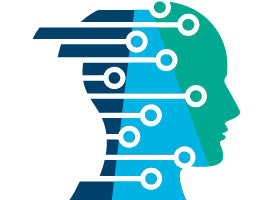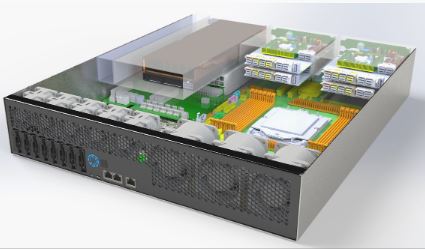
By Michael Bradley, Commercial Regional Sales Manager
With movies such as Terminator and iRobot gracing movie screens these days, the cause for concern regarding artificial intelligence (AI) is understandable. However, society is still just at the tip of the iceberg when it comes to the true power of AI machines and computers. The following infographic will explain the evolution of AI and how OSS is helping to push the limits of artificial intelligence.

View larger as a pdf View text version
Moore’s law states that the speed and capabilities of computers will double every two years. Components of these high-performance computers will continue to develop allowing more unique systems to be built to handle the ever-changing landscape of the AI framework. For example, One Stop Systems (OSS) has developed an all-in-one server and storage solution, 3U Short Depth Server, that can be seen in mobile command centers, autonomous trucks, and other applications where the most advanced AI frameworks must take place.
Here at OSS, we work hand in hand with the companies who continue to push the envelope of artificial intelligence. It is through these partnerships that we are able to build products such as the Rigel Edge Supercomputer, which is pound for pound the most powerful rugged supercomputer available on the market.
So, whenever you feel like becoming a supervillain and want to develop a robot that can take over the world, just know that OSS has the capabilities to design a system for you that will meet the most extreme demands and environmental requirements!
Click the buttons below to share this blog post!
_______________________________________________________________________________________1950 – Alan Turing develops the “Turing Test” as a measure of machine intelligence. It is a method of inquiry in artificial intelligence “AI” for determining whether a computer is capable of thinking like a human.
1955 – A proof of concept was initialized through Allen Newell, Cliff Shaw, and Herbert Simon’s, Logic Theorist. The Logic Theorist was a program designed to mimic the problem-solving skills of a human and was funded by Research and Development (RAND) Corporation.
1956 – The term Artificial Intelligence (AI) was coined by who many consider to be the father of AI, John McCarthy, at a convention at Dartmouth College.
1960 – John McCarthy opined that “computation may someday be organized as a public utility;” the underlying concept of cloud computing was stated.
1966 – John McCarthy hosted a series of four simultaneous computer chess matches carried out via telegraph against rivals in Russia. The matches lasted several months, and the result was that McCarthy lost two of the matches and drew two.
1970 – Marvin Minsky states that within 3 to 8 years, machines will have the general intelligence of an average human being.
1980s – Edward Fiegenbaum developed an “expert system” which mimicked the decision-making process of a human expert.
1990 through 1995 - Carnegie Mellon University began building self-driving cars, integrating neural networks into image processing and steering controls. In 1995, Carnegie Mellon researchers took their self-driving car, called NavLab 5, to the road, traveling 2,797 miles from Pittsburgh to San Diego.
1996 – IBM’s Deep Blue is introduced. A chess playing computer consisting of IBM RS/6000 SP Supercomputer with 30 PowerPC 604, 120 MHz CPUs and 480 custom VLSI second-generation "chess chips"
2011 – IBM’s Watson wins Jeopardy. Watson is a computer system that can answer questions that are poised in natural language processing (NLP). Watson uses a cluster of ninety IBM Power 750 servers, each of which uses a 3.5 GHz POWER7 eight-core processor, with four threads per core. In total, the system has 2,880 POWER7 processor threads and 16 terabytes of RAM.
2021 – Autonomous Semi-Truck company, TuSimple “completed the world’s first fully autonomous semi-truck run on open public roads without a human in the vehicle and without human intervention,” according to a news release. The 80-mile, one-hour and 20-minute drive began in Tucson, Ariz., and ended in Phoenix.
_______________________________________________________________________________________

Companies today are being asked to do more with data than ever before. Bigger AI models, faster insights, and workloads that don’t stay in one place, it’s a lot to keep up with. Traditional infrastructure just isn’t built for this kind of speed and flexibility.
The answer isn’t about throwing more hardware at the problem. It’s about building smarter, more agile infrastructure that adapts as demands change. And that’s where scale-out and increasingly, a blend of scale-out and scale-up come into play.

The rugged edge computing landscape is becoming increasingly complex with new generations of technologies, such as the latest AI focused GPUs, releasing annually rather than every 2-3 years. Whether the end application is commercial or defense, rugged edge servers must not only deliver cutting-edge compute performance but also withstand extreme environmental conditions.